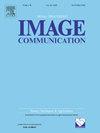SJND: A Spherical Just Noticeable Difference Modelling for 360° video coding
IF 2.7
3区 工程技术
Q2 ENGINEERING, ELECTRICAL & ELECTRONIC
引用次数: 0
Abstract
The popularity of 360° video is due to its realistic and immersive experience, but the higher resolution poses challenges for data transmission and storage. Existing compression schemes for 360° videos mainly focus on spatial and temporal redundancy elimination, neglecting the removal of visual perception redundancy. To address this issue, we exploit the visual characteristics of 360° equirectangular projection to extend the popular Just Noticeable Difference model to Spherical Just Noticeable Difference. Our modeling takes advantage of the following factors: regional masking factor, which employs an entropy-based region classification and separately characterizes contrast masking effects on different regions; latitude projection characteristics, which model the impact of pixel-level warping during equirectangular projection mapping; field of view attention factor, which reflects the attention variation of the human visual system on 360° display. Subjective tests show that our Spherical Just Noticeable Difference model is consistent with user perceptions and also has a higher tolerance of distortions with reduced bit rates of 360° pictures. Further experiments on Versatile Video Coding also demonstrate that the introduction of the proposed model significantly reduces bit rates with negligible loss in perceived visual quality.
SJND:用于360°视频编码的球面可注意差分建模
360°视频之所以受欢迎,是因为它的逼真和身临其境的体验,但更高的分辨率给数据传输和存储带来了挑战。现有的360°视频压缩方案主要侧重于消除空间和时间冗余,而忽略了视觉感知冗余的去除。为了解决这个问题,我们利用360°等矩形投影的视觉特性,将流行的刚可显差模型扩展到球面刚可显差模型。我们的建模利用了以下因素:区域掩蔽因子,它采用基于熵的区域分类,并单独表征不同区域的对比度掩蔽效应;纬度投影特征,用于模拟等矩形投影映射过程中像素级翘曲的影响;视场注意因子,反映人类视觉系统在360°显示时的注意变化。主观测试表明,我们的球面明显差异模型与用户感知一致,并且在360°图像的降低比特率下具有更高的失真容忍度。对通用视频编码的进一步实验也表明,该模型的引入显著降低了比特率,而感知视觉质量的损失可以忽略不计。
本文章由计算机程序翻译,如有差异,请以英文原文为准。
求助全文
约1分钟内获得全文
求助全文
来源期刊

Signal Processing-Image Communication
工程技术-工程:电子与电气
CiteScore
8.40
自引率
2.90%
发文量
138
审稿时长
5.2 months
期刊介绍:
Signal Processing: Image Communication is an international journal for the development of the theory and practice of image communication. Its primary objectives are the following:
To present a forum for the advancement of theory and practice of image communication.
To stimulate cross-fertilization between areas similar in nature which have traditionally been separated, for example, various aspects of visual communications and information systems.
To contribute to a rapid information exchange between the industrial and academic environments.
The editorial policy and the technical content of the journal are the responsibility of the Editor-in-Chief, the Area Editors and the Advisory Editors. The Journal is self-supporting from subscription income and contains a minimum amount of advertisements. Advertisements are subject to the prior approval of the Editor-in-Chief. The journal welcomes contributions from every country in the world.
Signal Processing: Image Communication publishes articles relating to aspects of the design, implementation and use of image communication systems. The journal features original research work, tutorial and review articles, and accounts of practical developments.
Subjects of interest include image/video coding, 3D video representations and compression, 3D graphics and animation compression, HDTV and 3DTV systems, video adaptation, video over IP, peer-to-peer video networking, interactive visual communication, multi-user video conferencing, wireless video broadcasting and communication, visual surveillance, 2D and 3D image/video quality measures, pre/post processing, video restoration and super-resolution, multi-camera video analysis, motion analysis, content-based image/video indexing and retrieval, face and gesture processing, video synthesis, 2D and 3D image/video acquisition and display technologies, architectures for image/video processing and communication.
 求助内容:
求助内容: 应助结果提醒方式:
应助结果提醒方式:


